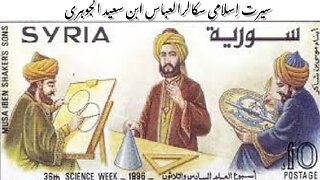Premium Only Content

Biography of Sultan Tughril 1st Sultan of Seljuk Empire سلطان طغرل کی سوانح عمری
#TughrilSultan #EmpireBuilding #IslamicHistory
Biography of Sultan Tughril 1st Sultan of Seljuk Empire
Dekhti Aankhooon aur sountay kaanoon ko Asslamoalaikum, sisters, brothers friends and elders, In these Islamic Seljuk Empire informative video, we present a comprehensive biography of Sultan Tughril, the inaugural Sultan of the Seljuk Empire. Discover the key events that shaped his leadership, his military conquests, and the strategies he employed to unify and expand his empire. Gain insights into his role in the development of Islamic governance and culture during a transformative period in history.
Abu Talib Muhammad Tughril ibn Mikail better known as Tughril was a Turkoman chieftain, who founded the Seljuk Empire, ruling from 1037 to 1063.
Tughril united many Turkoman warriors of the Central Asian steppes into a confederacy of tribes and led them in conquest of Khorasan and eastern Persia. He would later establish the Seljuk Sultanate after conquering Persia and taking the Abbasid capital of Baghdad from the Buyids in 1055. Tughril relegated the Abbasid Caliphs to state figureheads and took command of the caliphate's armies in military offensives against the Byzantine Empire and the Fatimids in an effort to expand his empire's borders and unite the Islamic world.
Before the advent of the Seljuks, Persia was divided between several warring local powers, such as the Saffarids, Buyids, Kakuyids, and Ghaznavids. As a result, it suffered from continuous war and destruction. However, under Tughril peace and prosperity were brought to the country and to Mesopotamia, a transition that was further reinforced due to the Seljuks' assimilation to Iranian-Muslim culture.
"Tughril" was the Old Turkic word for a bird of prey, possibly the Crested goshawk. In early Turkic history and culture, starting from the Uyghur Khaganate and onwards, it was used as a personal name.
Tughril was born in c.993, most likely in the Central Asian steppes, where nomadic Oghuz Turks were roaming to find pasture for livestock. After the death of his father Mikail, Tughril and his brother Chaghri were reportedly raised by their grandfather Seljuk (the eponymous founder of the Seljuks) in Jand. It was seemingly during this period that the Seljuk family converted to Islam, at least nominally. In the following decades, the Seljuks were employed as mercenaries under the warring factions of Transoxiana and Khwarazm, in exchange for pasture for their herds.
In the 1020s, Tughril and his other relatives were serving the Kara-Khanids of Bukhara. In 1026, the Kara-Khanids were driven out of Bukhara by the Ghaznavid Sultan Mahmud of Ghazni. Seljuk's son Arslan Isra'il fled to a place near Sarakhs, where he asked Mahmud for permission to settle in the area in return for military aid. Mahmud, however, had Arslan Isra'il put in prison, where the latter soon died. Meanwhile, Tughril and Chaghri remained loyal to their Kara-Khanid overlords, although there were disputes between them in 1029; in 1032, they fought alongside the Kara-Khanids at the Battle of Dabusiyya.
After the Kara-Khanid ruler Ali-Tegin's death, however, the Seljuks changed their allegiance to the ruler of Khwarazm, Harun, but were repelled by the Oghuz ruler Shah Malik in 1035. The Seljuks then went to the same place as Arslan Isra'il, and asked the son of Mahmud, Mas'ud I, for asylum. Mas'ud, however, considered the nomadic Turks to be dangerous and sent an army under his commander-in-chief Begtoghdi. The army was shortly defeated by the Seljuks, who forced Mas'ud to surrender Nasa, Farava and Dihistan in return for Seljuk recognition of Ghaznavid authority and protection of the region from other Turkic tribes.
In 1037, the Seljuks also forced the Ghaznavids to cede them Sarakhs, Abivard and Marw. The Seljuks then slowly began to subdue the cities of Khorasan, and, when they captured Nishapur, Tughril proclaimed himself Sultan of Khorasan.
Mas'ud, after having returned to Khorasan, expelled the Seljuks from Herat and Nishapur. He soon marched towards Merv to completely remove the Seljuk threat from Khorasan. His army included 50,000 men and 12 to 60 war elephants.
So sisters brothers friends and elders, we are going to described tomorow The Battle of Dandanaqan during Sultan's of Tughril. Allah Hafiz
================================
-
 7:53
7:53
ISLAMIC HISTORY
12 hours agoBiography of Al-Abbas ibn Said al-Jawhari سیرت العباس بن سعید الجوہری
8 -
 LIVE
LIVE
SpartakusLIVE
6 hours agoI'M BACK || Quads w/ The Boys
667 watching -
 9:33
9:33
Ken LaCorte: Elephants in Rooms
9 hours ago $0.90 earnedWhy Do Black Men Love Big Butts?
12.8K5 -
 2:12
2:12
From Zero → Viral with AI
1 day ago $0.70 earned🚀 AI Marketing Isn’t Just for Big Brands Anymore — Here’s Why
17.8K8 -
 9:51:58
9:51:58
Dr Disrespect
13 hours ago🔴LIVE - DR DISRESPECT - 10 WINS ON CONTROLLER - BO7 TOMORROW
295K20 -
 1:24:56
1:24:56
Glenn Greenwald
7 hours agoTrump Declares Cities as the Enemies Within; Reagan Appointed Judge Slams Trump Over Speech Crackdowns; American ER Doctor on Gaza Atrocities | SYSTEM UPDATE #524
121K86 -
 LIVE
LIVE
I_Came_With_Fire_Podcast
13 hours agoPete Hegseth and the Chamber of Standards | Digital IDs | Taiwan Chips & Salsa | CDL Crisis
315 watching -
 2:01:46
2:01:46
Adam Does Movies
12 hours ago $0.26 earnedTalking Movies + Ask Me Anything - LIVE
14.9K -
 29:11
29:11
Nick Shirley
5 hours ago $2.62 earnedPortland has Fallen... ANTIFA Take Control of City
16.9K29 -
 1:19:00
1:19:00
VapinGamers
4 hours ago $0.74 earnedJump Space - We All Scream in Space - Early Access - !rumbot !music
16.1K1